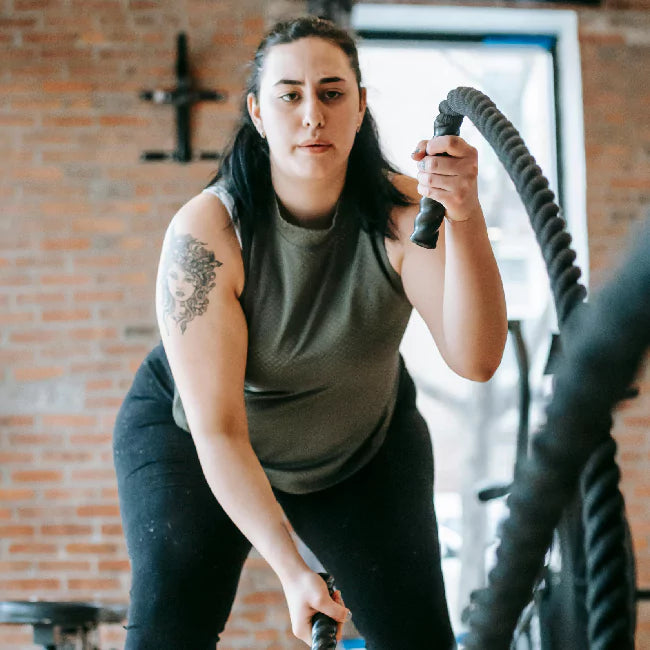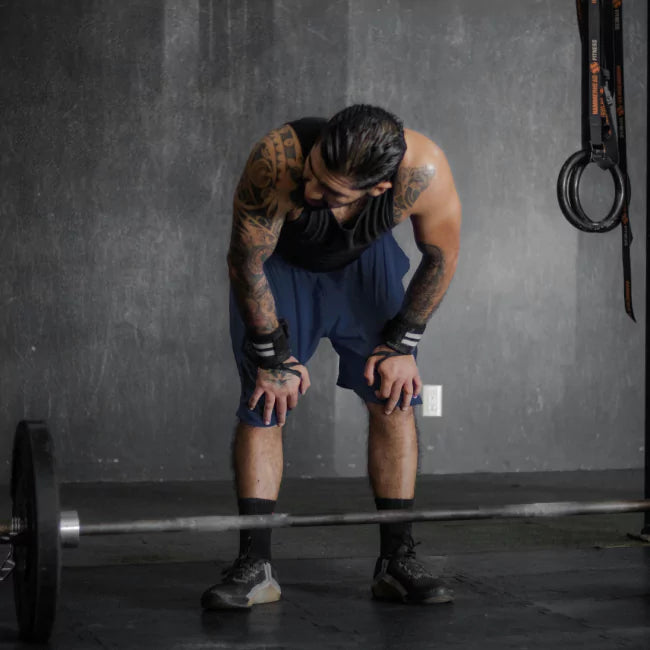The Gluteal Fold: How to Target the Underbutt for Weight Loss with the Top 5 Gluteal Exercises
 By: by Amino Science
By: by Amino Science

The gluteal fold or gluteal crease is that area just under your butt, specifically that space on the lower border of the gluteus maximus muscle that is also known as the upper thigh. Many people have a hard time losing the fat that clings to the gluteal furrow—much like so-called "love handles" and "saddlebags," the fat that forms around the body's midsection and hips is notoriously hard to lose.
Why is this fat so hard to eliminate, how can diet help shed those last few pounds, and what gluteal fold exercises accentuate a more prominent fold separating the buttocks and thighs? We have all these answers and more, including why some people may want to consider buttock reconstruction surgery.
Why Does Fat Cling to the Gluteal Fold?
From an evolutionary standpoint, both men and women accumulate fat on their torsos for many reasons: fat storage exists to guard against times of famine and to insulate the body during harsh winters. While most people in the modern world have the opposite issue (an overabundance of food, much of which is unhealthy), our bodies are still designed to cling to fat. Fat for fuel and fat for insulation equates to fat retention throughout our midsections.
However, the most basic anatomic study reveals that men and women store fat (adipose tissue) on their frames differently. Men may find that they have what's known colloquially as a "beer gut," fat storage between the ribs and waist, while women often store fat in their hips, thighs, and buttocks. There may be an evolutionary reason for this as well.
Scientific surveys show that a woman's waist-to-hip ratio correlates with higher cognitive abilities in her children, specifically that women with an hourglass shape who have a larger hip to waist circumference have significantly higher cognitive test scores (as do their children) than women who store fat more evenly throughout the body.
The possible explanation for this phenomenon is that neurodevelopmental resources are stored in lower body fat, like omega-3 fatty acids, which also contribute to neurocognitive abilities when they're prioritized in the diets of female children in particular. Evidence suggests the DHA omega-3 contribution to breast milk helps improve math scores in children more predictably than money spent on education. These findings have been verified in countries across the globe.
In addition, the babies of teenage mothers with a low hip-to-waist ratio (meaning an hourglass or pear-shaped body) are better protected against the cognitive reductions associated with teen births.
So, if you wonder why this fat clings so tenaciously to the female form, the reason is at least positive: it's where brain-developing assets are stored.
These findings have also led researchers to hypothesize that the curvy Marilyn Monroe body type found so attractive by a significant portion of men may be in part due their biological imperative to produce intelligent offspring.

Diet for Gluteal Fold Weight Loss
Once you're a fully cognitively developed adult trying to get into shape, extra fat on the upper limit of the thigh just below your butt is unnecessary, and for some, it's a real issue when it comes to their self-esteem and body positivity. One way to eliminate fat in the gluteal region and throughout the body (including visceral body fat that could be lingering in organs like the liver) is to follow a ketogenic diet.
The keto diet prioritizes healthy fatty foods over sugary foods like carbohydrates. In order to reach the desired state of ketosis, dieters must adhere to a macronutrient ratio of 75% fats, 20% protein, and 5% carbs.
The body's ketogenic metabolism is another remnant of evolutionary development, as it drives fat storage for use in times of famine. This metabolism kicks in to take the place of sugar (glucose) in times of scarcity. Once in ketosis, your body starts burning fat in the form of ketones, and in doing so, can eliminate fat from your butt, your lower limbs, and your midsection.
The keto diet can not only target unseen and stubborn fat, but it also helps some people with type 2 diabetes better manage their condition without the need for medication.
Bonus: keto foods like avocados, nuts, and fish contain the omega-3 fatty acids that aid brain development, so you can lose that gluteal fat storage without saying goodbye to the omega-3 advantage.

Top 5 Gluteal Fold Exercises
Here are five exercises you can bring to the gym on leg day that help target your underbutt, or the gluteal sulcus area if you want to get fancy with terminology. If you're hitting the gym to bring muscle development to your gluteal fold area and lose fat in the process, we suggest you supplement with our Athletic Performance blend of aminos, because new muscle cannot form without a full balance of all nine essential aminos.
1. Squats
- With your feet shoulder width apart, cross your arms and place a hand on each shoulder (or hold a barbell across your shoulders to maintain upper body posture).
- Next, shift your weight behind you, more to your heels than the balls of your feet to protect your knees.
- Squat down into a 90-degree angle (the lower you go the more you target the glutes).
- Return to the starting position.
- Challenge yourself to increase the number of reps you do each day. Start with 10, then 20, then 50...perhaps all the way to 100!
This exercise also helps target your quad strength (the muscle on the front of the thigh).
2. Step-Ups
- Find a step or stair (no taller than your own knees) and step up onto it with one leg: this is your base leg.
- When you step up, kick back with the other leg, keeping your hands on your hips for support (or grab a couple of weights to add more power to this exercise).
- Repeat on the same leg 15 times before switching to the other leg.
- Do at least 3 reps each side.
This move helps to strengthen the legs, tone the area of the gluteal-fold flap, and improve your balance.
3. Kneeling Squats
- Use a barbell (either loose or in a Smith machine as seen in the video) to perform the same squat discussed in exercise #1 on this list, but this time from the knees.
- Focus on squeezing the buttocks together as you perform the exercise to maximize the movement.
- Perform 15 reps (you can increase reps once you've gained enough strength).
This modification really concentrates the activity around your glutes instead of dispersing the workout over the entire lower body.
4. Gluteal Deadlifts
- With your feet shoulder width apart, place your hands on the barbell (whether on lifting blocks or in a Smith machine), with your palms either over or under the bar.
- Keep your arms straight as you lift the weight with your hips and glutes.
- Complete 10 to 15 reps. Be sure to protect your back during this lift, possibly with a weight belt or the aid of a trainer.
Deadlifting with a focus on your glute development is a more advanced lift intended for those who are already comfortable with traditional deadlifting and have the confidence that they can do so safely without jeopardizing their backs. It's important that you use a Smith machine or lifting blocks as this is not a full deadlift (from the floor), but a half-rep from about the height of your knees to target the glutes and get them to pop away from the gluteal fold, creating definition and rise at the lower limit of the buttock.
5. Hamstring Curls
- Locate a seated hamstring curl machine and select the weight appropriate for you (the hamstring curl should take place solely in the lower body; if you have to engage your back muscles, the weight is too high).
- Pull down the bar and squeeze at the bottom of the pull.
- Perform 15 reps.
Hamstring curls can also be done with the aid of a medicine ball (under the feet), a stability ball (under the calves), or with a seated hamstring curl machine (as seen in the video). Use the equipment and version you're most comfortable with, either from a seated position with a machine, or a supine position with the aid of exercise balls. If you're using a weighted machine, be sure that you don't engage your upper body to curl your legs—the point is to target the hamstrings, the muscles on the backside of your thigh directly beneath the gluteal fold.

Gluteal Fold Surgery
Gluteal fold surgery or gluteal fold lipoplasty is a cosmetic procedure that creates a horizontal gluteal crease between the buttock and the thigh. If you eat well, work out properly, and still can't get the results you're looking for, a consultation at a plastic and reconstructive surgery office may offer the solution you are looking for.
Plastic surgery is no vanity project. It's an important intersection of medicine and mental health that can restore a sense of self to cancer patients who must lose certain body parts, resolve one's inner gender with their outer sex presentation, and remove symptoms of depression and anguish by fixing a feature that cannot be altered any other way.
For some, a surgical solution may mean butt implants that create a gluteal fold, for others, it may mean liposuction and gluteal reshaping. Once fat cells are created, they don't go away on their own, they only shrink or swell as you lose or gain weight.
Make an appointment with a trusted plastic surgeon to find out if your health and circumstances make you a candidate for gluteal fold surgery. But don't go into surgery unprepared! Stock up on Amino Co's Surgical Recovery blend of amino acids to prep your body and accelerate healing.

Gluteal Fold Pain
Gluteal fold pain might also lead you to a doctor's office. This is known as deep gluteal fold syndrome and is characterized by numbness in the buttocks or down the back of your legs. Gluteal fold syndrome could be the result of a pinched nerve, compressed blood vessels, or piriformis syndrome (an issue with the piriformis muscle under your glutes that is intertwined with your sciatic nerve).
If you have a hard time sitting for long periods of time, unexplained pain in your lower back, or numbness, it's important to see a doctor and eliminate causes such as spinal damage or tumors that may be pressing against your nerves. However, if your discomfort is a simpler matter of a tight or swollen piriformis muscle, there are additional gluteus and piriformis stretches you can perform to relieve lower body and gluteal pain.

Know When to Fold 'Em
Now your knowledge of the butt and its gluteal fold is perfectly well-rounded. We hope these tips for eliminating unwanted fat from one of the most stubborn areas of the body help you achieve your goals of being healthy and happy with your backside.

Up to 25% off Amino
Shop NowTAGS: strength training weight loss
Join the Community
Comments (0)
Most Craveable Recipes




 833-264-6620
833-264-6620



















